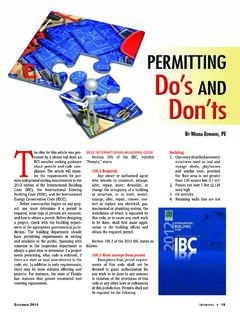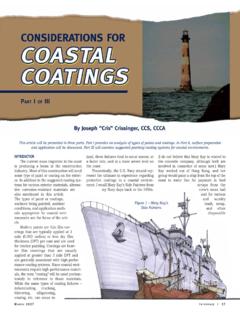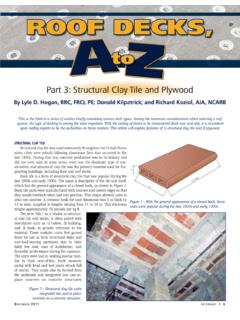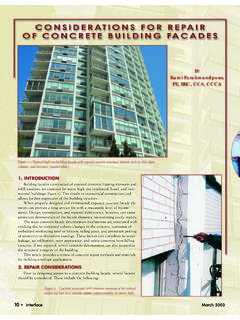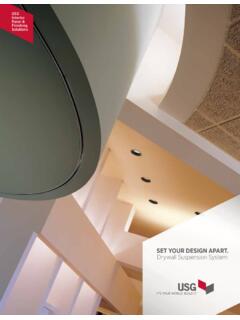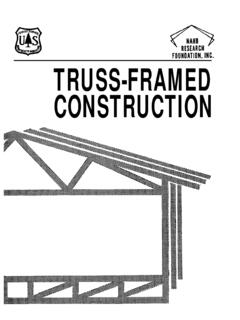Transcription of Creative Solutions for Challenging Curtain Wall Conditions
1 Photo 1 Unitized Curtain wall anchor. INTRODUCTION Aluminum-framed Curtain walls are highly engineered, popular, attractive wall systems that are often used for feature areas of buildings as well as for entire building fa ades. While the manufacturer s standard details and performance tests address typi-cal field-of-wall Conditions and performance issues, the desire to improve performance of atypical details often requires forethought and creativity. 2 2 In t e r f a c e The authors have experience designing various types of Curtain wall systems, inves-tigating problems with existing systems, and observing Curtain wall construction both in the factory and in the field. This arti-cle will present some Solutions developed to help design and installation teams to over-come project challenges and meet aesthetic design objectives for common and unusual detail Conditions encountered on recent aluminum-framed Curtain wall projects.
2 ANCHORAGE Unitized Curtain Wall Anchors Anchor plates for multistory unitized Curtain walls are often recessed into the top surfaces of concrete floor slabs (Photo 1). Providing recessed anchor Conditions has a number of benefits, with the primary one being that interior flooring is not inter-rupted at each Curtain wall anchor. The recessed areas are typically grouted solid after installation and final adjustment of the completed Curtain wall anchor assemblies. These slab cutouts should be considered during the original design of the building structure; adequate thickness and reinforc-ing is needed at the slabs, and pour stops or other edge metal (if present) must be inter-rupted. If the cutouts are not reviewed until the Curtain wall subcontractor becomes involved and the structural design (and perhaps some structural work) is already complete, the slab edge Conditions may not be adequate to accept the cutouts.
3 This could wreak havoc on the design intent for the interior floor and wall finishes and/ or require installation of more-complicated and costly slab edge anchor assemblies. It may be tempting to eliminate these cutouts at roof levels (where flooring is not present) in order to save cost, though doing so may have unforeseen consequences. Roof membranes may be located several inches above the Curtain wall anchors, though roof vapor barriers are normally located down on the top surface of the structural deck. Experience from past projects has shown Ja n u a r y 2 0 1 4 RCI October 111/5/2013 1:06:16 PM Photo 2 Multistory modular Curtain wall units installed with glazing pocket anchors. tain wall units are fitted with perime-ter glazing pocket flange anchors, the installation is often faster and the con-struction of higher quality compared to stick-built systems. This construction includes the inter-face with the walls that form the rough opening.
4 A glazing pocket flange anchor is an extruded aluminum section that consists of two main compo-nents: 1) A flange (similar to a nailing flange on a vinyl window), and 2) an adapter that fits into the glazing pock-et. The adapter is commonly square-, U-, or F-shaped. The adapter must be designed to fit securely within the glazing pocket, and it must be mechan-ically attached and sealed to the Curtain wall framing. The dead load of the Curtain wall is initially transferred to the building structure through the glazing pocket flange anchor, so an analysis must be conducted to confirm that the flange anchors and the attachments to the Curtain wall and the structure are adequate. If the Curtain wall spans multiple floors, the corners of the glazing pocket flange anchors can be fully welded to improve strength and weather-tightness. Installation of these modular units is similar to installing a flanged window.
5 The Curtain wall is hoisted into place, it is attached to the structure by fastening through the flange to the structure, and the flange is stripped in with flashing membrane. Depending on the size of the openings and the design loads on the walls (including the self weight of the Curtain wall), supplemental dead-load and wind-load anchors may be required at floor lines. Slab deflection and thermal move-ment must be taken into account , by including slotted holes in the flanges and that installation of roof vapor barriers at Curtain wall anchors is extremely chal-lenging and often poorly executed. Anchors may need to be boxed out with plywood or sheet metal to allow a reliable membrane wrapping, and the added cost of the boxes may offset the savings discussed above. Most anchorage components consist of carefully engineered and machined alu-minum parts. It is good practice to use anodized or painted aluminum for these components to provide a barrier between the aluminum and the cementitious grout used to fill the cutouts.
6 If bare (mill) alumi-num is used, a field-installed coating, such as a spray- or brush-applied bituminous product, can be used after installation. Glazing Pocket Flange Anchors Unitized Curtain walls are often a viable alternative to field-built systems. Although most commonly used for continuous clad-ding on large building fa ades, these pre-manufactured systems are gaining popular-ity for use in multistory punched openings (Photo 2). When these large, modular cur-Ja n u a r y 2 0 1 4 In t e r f a c e 2 3 Photo 3 Glazing pocket flange anchor sealed with silicone membrane. by stripping in the flanges with a flexible membrane product such as an extruded silicone sheet membrane (Photo 3) or EPDM membrane. Typically, self-adhering rub-berized asphalt peel-and-stick membrane cannot handle the shear forces present in the flashing membrane. Field air and water testing (Photo 2) on these units prove that high-water and air-resistant penetration levels can be achieved despite the fast installation.
7 On a recent project in the northeast , the Curtain wall contractor installed 28 by 8-ft., weathertight Curtain wall units in a single day. This advanced the construction schedule by allowing the inte-Photo 4 Membrane flashing installed in the glazing pocket around the perimeter of a Curtain wall. 2 4 In t e r f a c e rior fit-out work to start much sooner than if the Curtain walls had been stick-built in the field. PERIMETER FLASHING Sill Flashing Perimeter Conditions and, in particu-lar, sills are common problem areas for Curtain wall systems. Often perimeter con-ditions consist of only single or dual sealant joints, though use of a membrane or metal sill flashing will improve the durability and the performance of the interface. Two gen-eral approaches for flashing Curtain wall sills are 1) extending membrane or metal sill flashing under the wall system (similar to window pan flashings) and 2) sealing and clamping a flashing member into the glazing pocket.
8 Sill anchorage is an important consid-eration when designing sill flashing condi-tions. Stick-built Curtain wall systems are often supported by T-shaped or F-shaped anchors that bear directly on the top of a concrete slab or curb at the sill. Unitized systems normally include a continuous starter sill at the base of the wall. Both T/F anchors and starter sills include anchor bolts into the substrate below. Modification of standard anchorage details to simpli-fy flashing work may be an option for some window systems, though it is typically not feasible for Curtain wall systems (with the exception of the glazing pocket flange anchorage options discussed above). When sill flashing pans are used, all anchor penetrations through the flashing should be sealed. These seals must be particularly reliable, because substrates for the anchors and flashing are typically not sloped toward the exterior.
9 Water may pond around anchor penetrations on level or slightly depressed surfaces. To improve durability of seals, consider enhancing liq-uid adhesive seals with gasket-type seals between T/F anchors and flashing, or require membrane flashing covering the base of the T/F anchor. Though this tra-ditional through-wall flashing method has been used successfully on all types of glazed systems, other flashing methods exist that take advantage of the mullion geometry and zoned drainage common to many stick-built Curtain wall systems. For stick-built pressure-glazed systems, where glazing pockets are accessible during installation, extending membrane flashing into the glazing pocket offers a good alter-native to through-wall flashing. Since the Ja n u a r y 2 0 1 4 horizontal and vertical mullions are of simi-lar shape, one flashing method can typically be used around the full perimeter of the Curtain wall (Photo 5).
10 Membrane flashing can be adhered to the outer face of the mul-lion tube and clamped securely into place using the pressure plate. The design of the membrane flashing (sometimes called a transition membrane) should consider a variety of topics, such as: Spanning the gap between the cur-tain wall and the rough opening Accommodating deflections between the Curtain wall and the building structure (as well as out-of-plane deflections) Compatibility with adjacent con-struction, including air barrier materials, Curtain wall frame seals, etc. Build-up of materials in the glazing pocket Remaining airtight and watertight under design wind loads This membrane flashing also provides added bond surface (when compared to tra-ditional sealant joints) and can be particu-larly helpful in dealing with the hollow ends of vertical mullion extrusions, which can be extremely difficult to bond to reliably with sealant alone. Several large manufacturers of build-ing enclosure products (including at least one roofing company and several seal-ant manufacturers) now offer transition membranes designed specifically for these applications.
